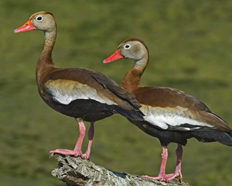Time to learn about Ducks! How many songbirds were you able to identify from the past two weeks? If you missed last week’s Songbirds (Part 2) post, click here. This week, we will be learning about “Ducks”. These birds can be seen in ponds, fresh and saltwater marshes, freshwater lakes, agricultural fields, brackish waters, and wetlands. Grab your binoculars and go exploring with us!
Bird watching is an activity that is ageless – anyone can learn and appreciate the wonderous bird species. All you need are a pair of binoculars. Let us know if you can spot and identify one of these Ducks this week!
Black-bellied Whistling-Duck
Physical Description:
- Large, gooselike duck with a long neck, long legs, and short tail
- Males and females look similar with red bills, pink feet, white wing patches, and black bellies
- The head is brownish-gray with a white eye-ring
Habitat:
- Ponds, fresh marshes
- Favors shallow freshwater lakes; may come to those in open country, but seems to favor ponds surrounded by trees
- Frequent agricultural fields, particularly flooded rice fields
- Not strongly migratory
Diet:
- Mainly seeds (of various grasses) and grains
- Insects, snails, and other invertebrates make up less than 10% of diet
- When foraging, often in dry fields, also in irrigated land
Nesting:
- May mate for life
- Nests in colonies
- Clutch size: 12-16 eggs (whitish)
- Prefer to nest in natural tree cavities, but:
- Will use nest boxes
- Have been reported to nest on the ground
Click here for more information.
Blue-winged Teal
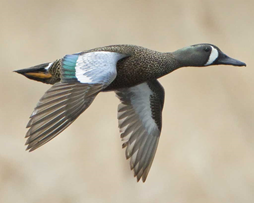
Physical Description:
- Seen in pairs and small groups in shallow ponds and wetlands across much of North America
- Long distance migrants, with some birds heading all the way to South America for the winter
- Take off early on spring and fall migration, leaving their breeding grounds in the United States and Canada well before other species in the fall
Habitat:
- Fresh ponds, marshes
- Summer: shallow freshwater marshes and ponds in open country, also brackish marshes near coast
- Migration and winter: any kind of shallow waters, inland or coastal
- Typically seen in Florida during winter months
- Flocks in migration are sometimes seen over ocean, many miles offshore
Diet:
- Plant material- mainly seeds (grasses, sedges, pondweeds, smartweeds) Snails, bivalves, insects, crustaceans, and other animal matter may be important in the diet at some seasons
- Forages in very shallow water, gleaning items from surface or swimming forward with head partly submerged
Nesting:
- Clutch size: 9-13 eggs (dull white or tinged olive)
- Nest site is on ground in prairie, hayfield, coastal meadow, sometimes several hundred yards from nearest water
- Shallow depression with some grass or weeds added, lined with down; usually well concealed by surrounding vegetation
Click here for more information.
Fulvous Whistling-Duck

Physical Description:
- Medium-sized duck with long neck and legs
- Head, neck, chest and belly buffy to tawny-cinnamon
Habitat:
- Freshwater wetlands, especially shallow impoundments managed for rice
- Flooded grasslands and pasture
Diet:
- 95% plant material, mainly seeds of aquatic plants and grasses
- Aquatic insects
Nesting:
- May pair for life
- Clutch size: 12-14 eggs (whitish, becoming nest-stained)
- Nest site is on ground next to water or in dense marsh just above water
- Nest is woven of grass, sedges, cattails, sometimes with canopy of same materials above.
- *Unlike most waterfowl, no down added to nest
*Note: Endangered Species
Click here for more information.
Mottled Duck
Male:
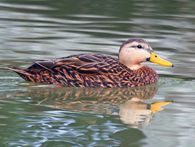
Female:

Physical Description:
- Medium-sized
- Male mottled ducks: lacks the mallard drake’s bright green iridescent head
- Female mottled duck: neck and head is lighter colored than its body feathers
- The easiest way to tell them apart is by bill color
- Male- olive green to yellow bill
- Female- orange to brown bill with dark blotches or dots
Habitat:
- Freshwater wetlands, ditches, wet prairies, and seasonally flooded marshes
Diet:
- Omnivores: seeds of grasses, aquatic vegetation, rice, aquatic invertebrates, and a few small fish
Nesting:
- Depression in grass. Lined with vegetation and down from female’s breast
- Clutch size: 5-13 eggs (dull white to olive color)
Click here for more information.
Wood Duck
Male:
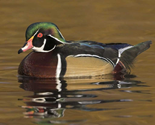
Female:
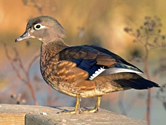
Physical Description:
- Uniquely shaped- boxy, crested head, a thin neck, and a long, broad tail
- In flight, they hold their head up high, sometimes bobbing it
- Silhouette shows a skinny neck, long body, thick tail, and short wing
- Males: glossy green head cut with white stripes, a chestnut breast and buffy sides
- Late summer, males lose their pale sides and bold stripes, but retain their bright eye and bill)
- Females: are gray-brown with white-speckled breast
Habitat:
- Wooded swamps, marshes, streams, beaver ponds, and small lakes
- They stick to wet areas with trees or extensive cattails
- Cavity nester, take readily to nest boxes
Diet:
- Seeds, fruits, insects and other arthropods (land- acorns and other nuts from forests and grain from fields)
- Variability, but plant materials make up 80% or more
Nesting:
- Breeding pairs search for nest cavities during early morning
- Clutch size: 9-14 eggs (dull white to pale buff)
- Cannot make their own cavity
- Typically placed where a branch has broken off and the tree’s heartwood has rotten
- Use cavities up to 1.2 miles from water
Click here for more information.
Be sure to keep sharing with us birds that you have spotted in your yards, parks, and in your community!
 0
0
